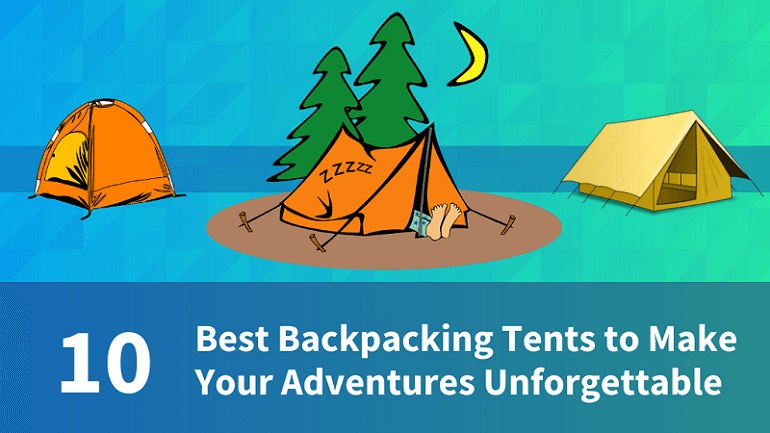
Taking the time to get out into the wilderness every now and then can help you unwind and get away from the hustle and bustle of everyday life. You can head out alone or with some special people to just enjoy nature and everything it has to offer. However, having the right equipment on your trip can either make or break your trip if you end up choosing the wrong gear.
When camping in the wilderness, your best friend is going to be your tent. This will be your home away from home and provide you a feeling of security from whatever nature throws at you. Because of this, you always want to make sure you are getting the best tent possible for your camping needs. New tents are lighter and more convenient than ever before, so you are spoiled for choice when it comes to finding a great option.
To help you get out into the wild with the right tent, we want to look at the best backpacking tents under 200. As we looked at a number of tents for backpacking, we looked at everything from the ideal sizes to respectable brand names to ensure we only give you the best options. Additionally, we also want to give you the essential background information to tenting so that you can know what kind of tents suit your camping style and needs. With that being said, let’s start to unpack everything that makes backpacking tents so great.
ALPS Mountaineering Zephyr
Featherstone 2 Person Backpacking Tent
KAZOO Outdoor Camping Tent
ALPS Mountaineering LYNX
Naturehike Cloud-Up
Kelty Salida Tent
AYAMAYA Ultralight
FLYTOP Backpacking Tent
MIS MOUNTAIN INN SPORTS Tent
Winterial Personal Bivy Tent
Before we look at the backpacking tents under 200, we first need to understand what makes the world of backpacking tents so special. From their unique designs to understanding what makes them tick. We want to make sure that you understand what you want out of a backpacking tent before you run out in excitement to get the rest of your camping gear ready.
People have been taking to the outdoors for many years with people sleeping in tents made of sticks and some choosing to just sleep under the stars. As technology continues to advance and push the limits of what can be created, the camping industry has taken the latest innovations and used them to create new tent technology to help make camping just a little easier.
This is where the backpacking tent came into existence. A traditional tent is a great way to get into the outdoors and stay comfortable, but they come with a number of drawbacks. For one, they are often very large and designed to focus on protection and space instead of weight and size. This was great when tents were made of basic fabrics and materials, but new advances are making classic tent styles obsolete.
Backpacking tents are a new offering in the camping industry that is helping explorers to get out into the wild without needing to carry around a heavy tent that only gets on your nerves. The philosophy behind the backpacking tent is to give the campers all the essential tent necessities they need without any added fluff or space that they really don’t need. Going camping with a tent should be about getting out there in the woods, so you really don’t need an entire house to bring with you. Just one look at a backpacking tent, and you’ll instantly recognize that it is meant for the thrill of camping.
What many people don’t realize about backpacking tents is that they are very versatile in their uses and flexibility. Whether you are looking for the best lightweight backpacking tent under 200 for a solo trip to clear your head or want the best 4 person tent under 200 for the whole family, there is a tent out there for everyone to enjoy the great outdoors. If you are wondering what makes a backpacking tent unique and so great for camping, we will now break down what you want to look for in any tent that you plan on camping with.
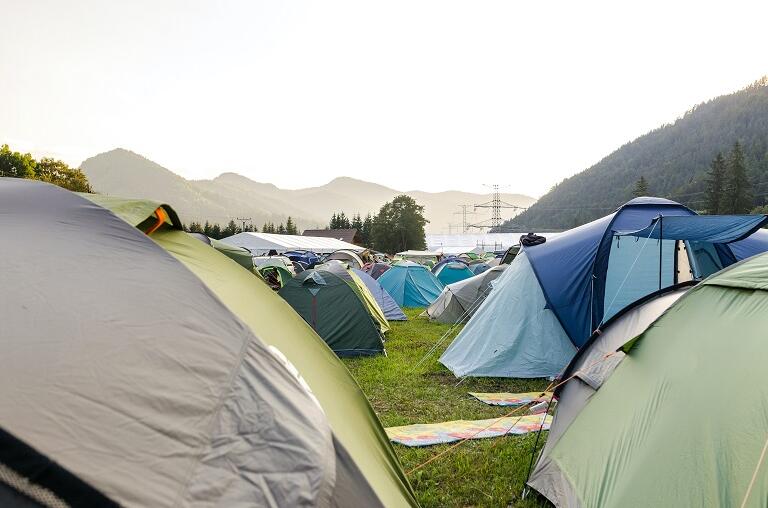
Understanding what makes a great tent is just as important as choosing the right place to camp. You may find a tent that looks like what you want only to find that it isn’t small enough to fit in your bag. Let’s take a look at what we think are some of the most important considerations any buyer needs to have when picking the best tent for their camping needs.
As the name suggests, a backpacking tent should be one that can hypothetically go with you when backpacking and not be a substantial burden. The weight of a backpacking tent can be a bit tricky to figure out realistically, so we will look at two different weight measurements later on to help you understand the difference between them.
Traditional tents can often require a few people to carry as they are designed to just create space and not care about the weight. As people started going further from society and wanted tents that could be taken by one person, the industry answered with backpacking tents. The average backpacking tent weights anywhere from 3 to 5 pounds for easy carrying. Surprisingly, the lightweight design of these tents has little negative effects on the strength or size of the tents as you can easily find the best 3 person tent under 200 weighing in at a fraction of what a traditional tent would weigh.
Something to keep in mind when picking a backpacking tent is what effect the weight will have on the cost and practicality of a tent. The lighter the tent is, the more you will likely have to pay as it is harder to develop lighter tents that are still practical to use. However, be advised that as the weight of a tent gets lighter and lighter, you will start to lose a little bit of protection that results from simply having less material on the tent.
Something that many people hold with great importance when picking a tent is how much space they have on the inside of the tent. Whether you are camping alone or going somewhere with a group, having enough space can be a nice luxury to ensure you are able to get a good night’s sleep and have room for all of your other camping gear to stay safe from the elements.
Every tent is a little different in design and space, so you will need to take a look around at the options that are in your price range so you get the most space per dollar. Some tents are designed to be longer for the taller camper as others take a higher priority for vertical space so that you can stand up with more freedom. Modern tents are getting really creative with their design so that campers can have as much space as possible without adding too much weight.
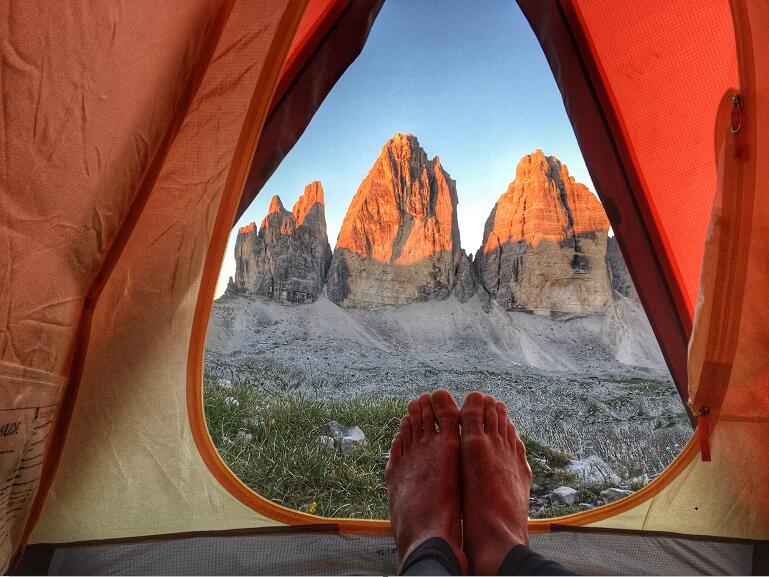
If you are camping with more than one person, you may want to think about how much space you would each want. Looking for the best 2 person backpacking tent under 200 may seem like the best way to find a tent for two, but it is usually advised you get a tent designed for one person more than will actually sleep in it. This helps keep ample space for both people and helps everyone out by reducing the feeling of being cramped and bunched up together.
Getting to the perfect campsite only to have your trip ruined by a storm is the last thing any camper wants to go through. This is where the very important aspect of tent durability comes into play. The durability of your tent can range from how strong its poles and pegs are to how much wind it can handle without flying away or collapsing.
As a general rule of thumb, a heavier tent will usually be sturdier than a lighter tent. A tent that weighs more usually has more material and larger structural support elements, so it will be better off facing wind and rain than a tent that you hardly even notice the weight of. This is not to say that lighter tents are flimsy and not suited for rain, as many new innovations are helping to make lighter tents stronger than older large tents.
If you know when you plan on tenting, you can likely already know how much durability is going to matter for your trip. Rain and wind aside, having a tent that you are confident will stay rigid and in the right shape gives you some added confidence on your trip. The last thing any camper wants is a tent collapsing on top of them in the middle of a rainy night.
The always relevant issues of the price are what can allow more people to get out and camp if the price is reasonable. The phrase “you get what you pay for” is as true with tents as it is with an exotic sports car. Luckily, the best backpacking tents under 200 can be all the tent anyone would need when looking to get out and enjoy nature.
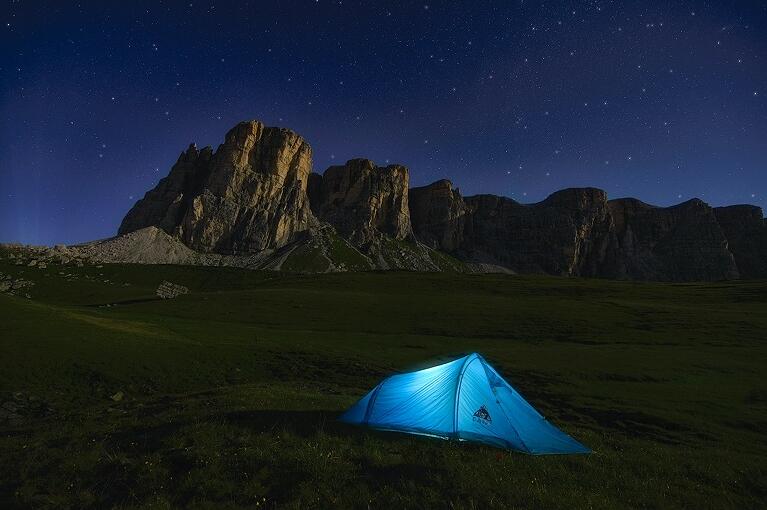
A more expensive tent will tend to be lighter to carry as more money has gone into the materials and designs that have made the whole thing easier to carry. With a cheaper tent, you will find a build quality that is not as nice and will be heavier than a more expensive tent. While it may seem like 200 dollars may not get you much tent, you can find some great options that we will walk you through later.
Something that can be confusing to first-time campers is to understand the difference between packaged weight and trail weight. While these may sound confusing to new campers, they are actually pretty easy to understand metrics. For packaged weight, that is simply the weight of a tent when you buy it and account for everything the manufacturer intends you to take with you when using the tent.
As for trail weight, that is the number that represents the essential components of the tent-like body, poles, and rain cover. The reason these two numbers are included is that many campers bring their own lightweight gear when backpacking to save some weight. If you have your own special pegs and rope, you can use the trail weight metric to see how much weight you can save when using your own gear instead of everything the manufacturer gave you to use.
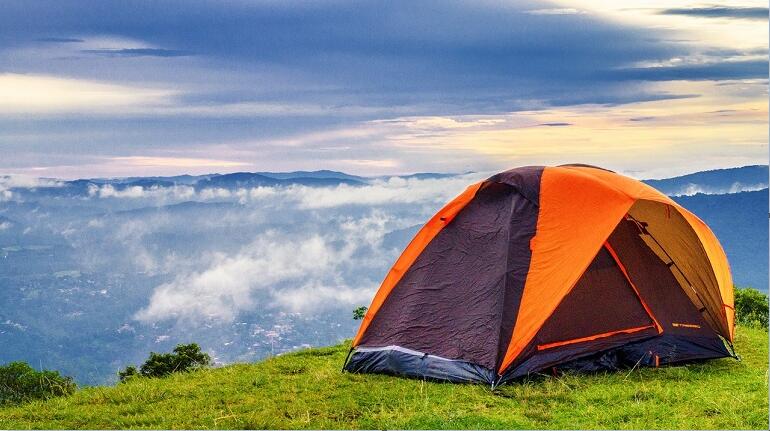
Many people only go camping in the summer, but there are a number of tents built for so much more. If you have the right gear to keep you warm or cool, the tent you use can help you to embrace the elements with comfort. You can find the best 4 season tent under 200 that will help you embrace the outdoors at any time of the year with the right rating.
Depending on where you are looking to camp, the footprint of your tent can be an important consideration. The footprint of your tent refers to the ground space it takes on the ground to set up your tent. In many cases, a tent will come with a footprint piece of fabric that will protect your tent floor from getting wet and dirty.
Then design refers to the physical design of a tent and how it looks. You can get a tent that suits your needs by looking at different designs for different needs. You can get tents that are shaped to represent a home or can get ones designed to be as small as possible.
Tent setup is a pretty self-explanatory term that refers to how you go about putting together your tent. The setup process can involve putting poles in the tent, nailing in the pegs, and being done with it in five minutes for some tent designs. For the most part, the setup for most standard tents will look roughly the same.
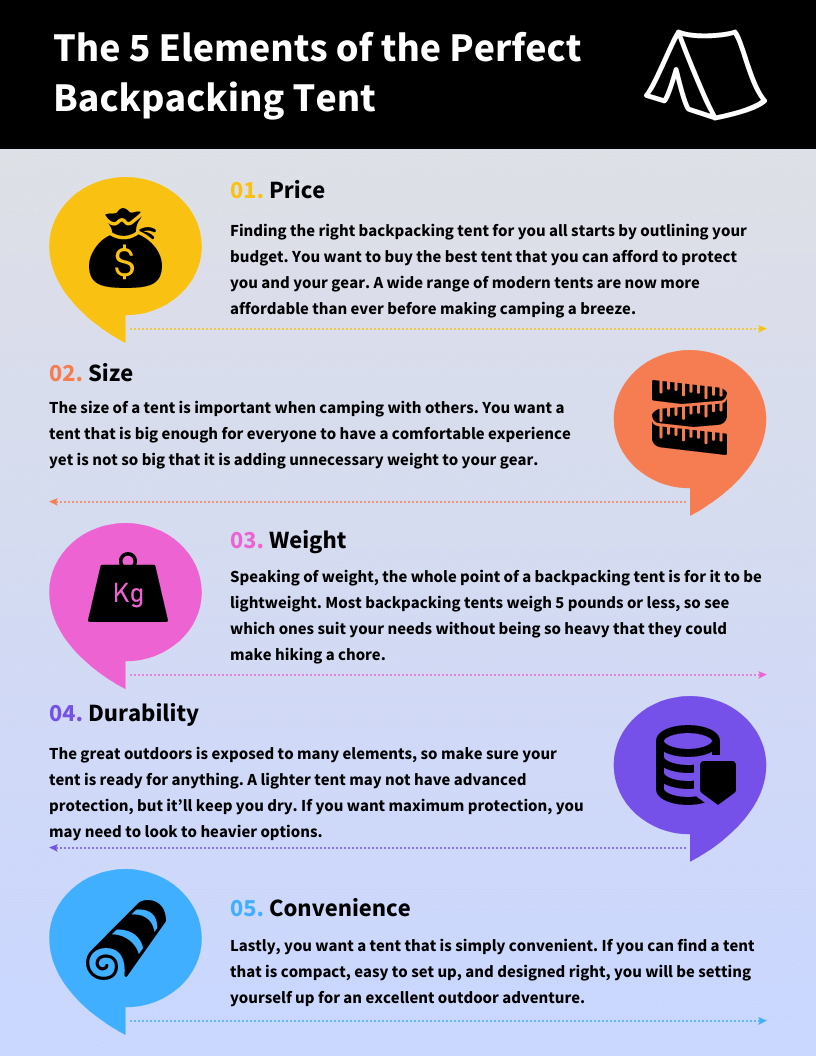
As the name suggests, the ALPS Mountaineering Zephyr was born to take on whatever challenges you are able to throw at it. A design that looks right out of the Everest base camp, this carefully designed tent is incredibly durable and promises to keep you warm and dry. A special coating resists the UV rays and water that ruins other tents as the two mesh doors allow for great ventilation throughout.
Pros
Cons
This backpacking tent is a great option for a team of two campers looking for a rugged backpacking tent to help them escape anywhere. The unique design allows this tent to essentially open up and lets you see the world around you with mesh protection. The freestanding design allows this tent to be moved around and set up with greater ease than the majority of the competition.
Pros
Cons
A unique offering from KAZOO, this backpacking tent is designed to keep you and your gear safe from the elements. The dual porches allow you to store all of your gear out of the elements while you relax in the comfortable interior. The four-season design allows this tent to go anywhere and do anything you want it to while setting it up easily and sturdily.
Pros
Cons
For the solo explorer looking for just the essentials, The ALPS Lynx is all the tent you need for all-season exploration. The design of this tent is very practical and can be set up by a single camper within a matter of minutes. Keep your belongings organized and gear safe with a multitude of storage options and excellent materials used to keep the heat in and weather out.
Pros
Cons
For you and two fellow campers, the Naturehike Cloud-up offers plentiful space and protection for your backpacking tent needs. Coming in at just 4.7 pounds, this tent is leading the class for three-person tent lightness. Upgraded ventilation systems and comparable UV protection mean that this tent is going to help keep the sun out and let the comfortable breeze in when wanted.
Pros
Cons
Kelty is a respected name in the tents, and their two-person backpacking tent is no exception to their great products. An easy to assemble design is helped with a color-coded setup help so you can be ready for action in minutes. The expansive rain coverage and spacious interior mean you and your gear will stay dry. Take off the rain cover on nice nights for a great sky view with a protective mesh.
Pros
Cons
A tent with plenty of personalities and ready to be used anywhere, the AMAMAYA Ultralight tent is a great companion for two campers looking for an easy to use and lightweight tent. This tent is designed to be easy to set up and move, which can be fully opened up for maximum breathability. For a solid tent that adjusts to your needs, look no further.
Pros
Cons
FLYTOP knows that their customers want with this stunning tent that looks ready to take on Everest. A comfortable sized interior pairs with a large and protective outer covering that will keep your gear safe and the harsh conditions outside. Its compact form factor means this tent can go inside or outside your bag without you even noticing the weight. Take on whatever trip you want with this durable and capable tent.
Pros
Cons
A compact package allows you to get the MIS MOUNTAIN INN SPORTS Tent where you want it and then sets up to be everything the solo camper needs for maximum comfort. The ample interior space is all you need for a simple getaway and is helped with a number of interior features that make the camping experience a little easier. This tent also has a generous amount of protection and rain coverage.
Pros
Cons
Solo camping is all about enjoying where you stay, and the personal Winterial Personal Bivy Tent wants to help keep it that way. The compact footprint of this tent gives you nearly limitless options as it will fit just about anywhere you could lay down. The sturdy pegs and covering keep the tent locked down and you dry wherever you take it. Escape the way you want to with this tent for the perfect solo getaway.
Pros
Cons
A common question shoppers have when choosing their tent is wondering what actually makes a backpacking tent different from a normal tent. While both standard and backpacking tents fulfil the same need, they go about doing so in slightly different ways.
With traditional tent designs, there is an emphasized focus on comfort and space above all else. You can get things like eight-person tents with substantial amounts of living space, but that tent could easily weigh upwards of 50 pounds. For those who like camping in maximum comfort and drive to their camping spots, traditional tents make a good deal of sense.
For those campers looking to get more remote with their exploring, backpacking tents seem to offer more flexibility. Being substantially lighter and suited for smaller numbers, backpacking tents will provide you with just the essentials you need in a tent at a fraction of the weight. Hikers and people who like to get out and explore are where the backpacking tent was designed to go.
Despite their lightweight construction and smaller design, backpacking tents can be very comfortable. Made from the same material as larger tents, a backpacking tent takes what makes a standard tent great and boils it down into a smaller package. They have ample space for all your gear and will keep you protected from whatever is outside the tent.
One thing to keep in mind is the difference in the purpose of a backpacking tent. While standard tents are designed for you to stay in them for a whole day with no issue, a backpacking tent is really only designed for sleeping and relaxing. Their smaller size is not ideal for staying inside as they are supposed to be used when hiking or spending most of your time outdoors. The smaller size and weight of backpacking tents also lead them to have a bit less protection from severe weather, which should be avoided when camping in general.
A common question buyers ask when shopping for backpacking tents is how heavy should the tents actually be. Depending on what kind of tent you are looking for and what you are comfortable carrying, you can find tents as light as 2 pounds and as heavy as around 7 pounds for larger backpacking tents.
What generally determines the weight of a backpacking tent is how large it is and how much equipment it comes with. If you are traveling solo, you can easily find 2-pound tents that will suit your needs all day long. However, the larger you need the tent to be, the heavier it is likely to be. As we looked at earlier, every tent comes with two weight configurations based on what equipment you use from the manufacturer and what you use from your own supply. In many cases, you can save around a pound in weight just by using the essential supplies that came with the tent alongside your own personal equipment.
Depending on how you plan on traveling or carrying your tent, there are different brands offering different ways for you and your tent to reach the camping spot. For most backpacking tents, they come in a very slim bag that is designed to fit right into your hiking bag so that it can be kept safe and secure inside your bag. On the other hand, there are also a number of options that can be attached to the outside of your hiking bag for added convenience.
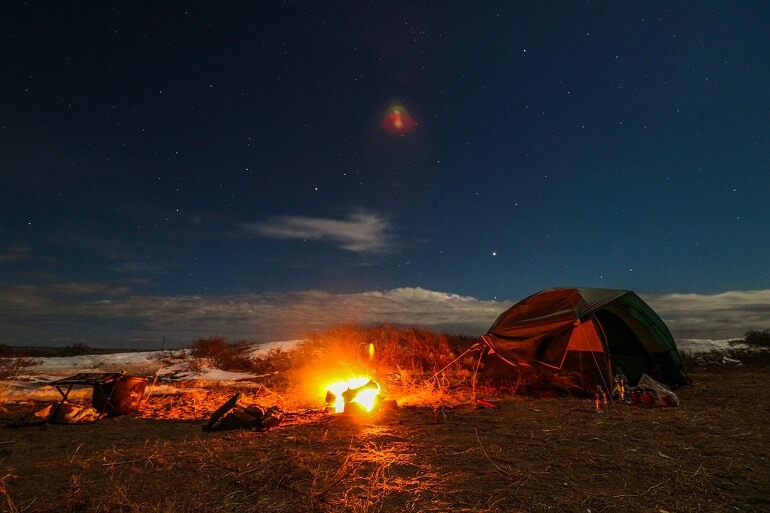
Every explorer wants just to get out there and see what nature has to offer, but it is always worth it to do some research to see what options are out there. For the backpacking tent, you have a number of excellent options that are all designed with a specific style of camper in mind.
For the sole camper looking to escape alone to the wild, there are great options like the Winterial Personal Bivy Tent that is all the protection and comfort you need when solo tripping in the outdoors. If you are looking to explore with others and want something a little larger, KAZOO offers a decently sized and lightweight option that has all the space you could want to share with someone else.
No matter your plans, we feel that there is a tent out there for everyone and hope that at least one of our best backpacking tents under 200 stuck out as the one to get you out and to explore.
© 2021 by OutdoorStuffGudies.com
OutdoorStuffGudies.com is a participant in the Amazon Services LLC Associates Program, an affiliate advertising program designed to provide a means for sites to earn advertising fees by advertising and linking to Amazon.com.